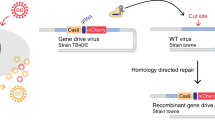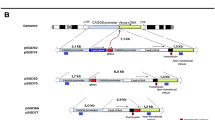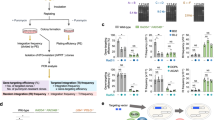Introduction of homologous DNA sequences into mammalian cells induces mutations in the cognate gene (original) (raw)
- Article
- Published: 06 November 1986
Nature volume 324, pages 34–38 (1986)Cite this article
- 874 Accesses
- 193 Citations
- 9 Altmetric
- Metrics details
Abstract
Injection of homologous DNA sequences into nuclei of cultured mammalian cells induces mutations in the cognate chromosomal gene. It appears that these mutations result from incorrect repair of a heteroduplex formed between the introduced and the chromosomal sequence. This phenomenon is termed ‘heteroduplex induced mutagenesis’ The high frequency of these events suggests that this method may prove useful for introducing mutations into specific mammalian genes.
This is a preview of subscription content, access via your institution
Access options
Subscribe to this journal
Receive 51 print issues and online access
$199.00 per year
only $3.90 per issue
Buy this article
- Purchase on SpringerLink
- Instant access to full article PDF
Prices may be subject to local taxes which are calculated during checkout
Additional access options:
Similar content being viewed by others

Viral gene drive in herpesviruses
Article Open access 28 September 2020


References
- Smithies, O., Gregg, R. G., Boggs, S. S., Koralewski, M. A. & Kucherlapati, R. S. Nature 317, 230–234 (1985).
Article ADS CAS Google Scholar - Thomas, K. R., Folger, K. R. & Capecchi, M. R. Cell 44, 419–428 (1986).
Article CAS Google Scholar - Lin, F. L., Sperle, K. and Sternberg, N. Proc. natn. Acad. Sci. U.S.A. 82, 1391–1395 (1985).
Article ADS CAS Google Scholar - Smith, A. J. H. & Berg, P. Cold Spring Harb. Symp. Quant. Biol. 49, 171–181 (1984).
Article CAS Google Scholar - Hudziak, R. et al. Cell 31, 137–146 (1982).
Article CAS Google Scholar - Folger, K. R., Thomas, K. R. & Capecchi, M. R. Molec. cell. Biol. 5, 59–69 (1985).
Article CAS Google Scholar - Capecchi, M. R. Cell 22, 479–488 (1980).
Article CAS Google Scholar - Sanger, F., Nicklen, S. & Coulson, R. Proc. natn. Acad. Sci. U.S.A. 74, 5463–5467 (1977).
Article ADS CAS Google Scholar - Ullman, A. Gene 29, 27–31 (1984).
Article Google Scholar - Beck, E., Ludwig, G., Auerswald, E. A., Riess, B. & Schaller, H. Gene 19, 327–336 (1982).
Article CAS Google Scholar - Hutchinson, C. A. et al. J. biol. Chem. 253, 6551–6560 (1978).
Google Scholar - Roth, D. B., Porter, T. N. & Wilson, J. H. Molec. cell. Biol. 5, 2599–2607 (1985).
Article CAS Google Scholar - Peabody, D. S. & Berg, P. Molec. cell. Biol. 6, 2695–2703 (1986)
Article CAS Google Scholar - Peabody, D. S., Subramani, S. & Berg, P. Molec. cell. Biol. 6, 2704–2711 (1986).
Article CAS Google Scholar - Hughes, S. et al. Molec. cell. Biol. 4, 1738–1746 (1984).
Article CAS Google Scholar - Dixon, L. K. & Hohn, T. EMBO J. 3, 2731–2736 (1984).
Article CAS Google Scholar - Johansen, H., Schumperli, D. & Rosenberg, M. Proc. natn. Acad. Sci. U.S.A. 81, 7698 (1984).
Article ADS CAS Google Scholar - Liu, C., Simonsen, C. C. & Levinson, A. D. Nature 309, 82–85 (1984).
Article ADS CAS Google Scholar
Author information
Authors and Affiliations
- Department of Biology, University of Utah, Salt Lake City, Utah, 84112, USA
Kirk R. Thomas & Mario R. Capecchi
Authors
- Kirk R. Thomas
You can also search for this author inPubMed Google Scholar - Mario R. Capecchi
You can also search for this author inPubMed Google Scholar
Rights and permissions
About this article
Cite this article
Thomas, K., Capecchi, M. Introduction of homologous DNA sequences into mammalian cells induces mutations in the cognate gene.Nature 324, 34–38 (1986). https://doi.org/10.1038/324034a0
- Received: 14 April 1986
- Accepted: 18 August 1986
- Issue Date: 06 November 1986
- DOI: https://doi.org/10.1038/324034a0